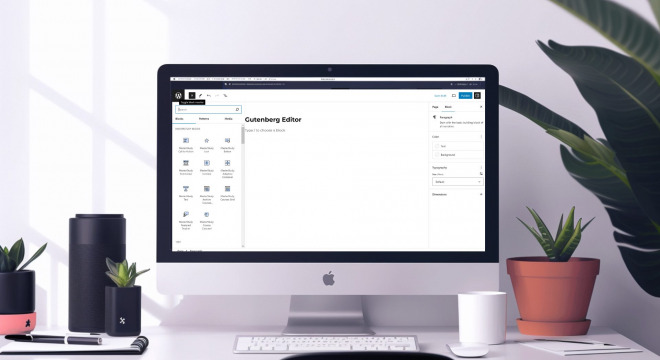Gutenberg, the WordPress block editor, was launched with WordPress 5.0 back in 2018. It started as a plugin but quickly became the default editor for WordPress.
The main goal of Gutenberg was to make building pages and creating posts easier and more visual. It lets you add rich content without needing to use shortcodes, making it simpler for anyone to manage their own website.
If you’ve tried Gutenberg before and didn’t like it, you might be surprised to know that it has improved a lot. Now in its 18th version, many new features and improvements have been added, with even more on the way.
In this article, we’ll look at the pros and cons of Gutenberg and explain why it could be the best choice for building your pages with the MasterStudy LMS plugin. Keep reading, and we might convince you to give Gutenberg another try!
Why You Should Use Gutenberg
Blocks
Gutenberg uses blocks to make content creation super easy. Blocks are pre-built sections for things like images, videos, forms, and buttons. You don’t need to be a tech expert. Just pick the blocks you need, add them to your page, and you’re good to go. This saves you time, which you can use for other important tasks.
Drag-and-Drop Functionality
Gutenberg’s drag-and-drop feature lets you quickly add elements to your website. Just drag a block to where you want it, and you’re done. This makes creating and designing web pages fast and hassle-free.
No More Shortcodes
With Gutenberg, blocks replace shortcodes, making it easier to create and fix your website. You don’t have to deal with confusing shortcodes anymore.
User-Friendly Interface
Gutenberg is very user-friendly. You can add blocks by clicking the plus button, and customize them using the settings button. The interface is intuitive and easy to navigate. You can even see how your content will look on the front end while editing.
Developer-Friendly
If you’re a developer, Gutenberg offers great tools to create custom blocks and themes. You can modify codes, use APIs, and integrate with other plugins to extend your website’s capabilities.
Mobile-Friendly
Gutenberg helps you make your website mobile-friendly. This means your site will look great on smartphones, tablets, and other devices. It also has features to help disabled users navigate and use your site easily.
Easy Layout and Design
With Gutenberg, creating layouts and designing pages is simple. It provides an intuitive interface and a rich library of customizable blocks. Just drag and drop blocks to create the layout you want.
Visual Design Background
Gutenberg’s visual design background lets you see all the elements and options as you work. You can instantly see the results of your changes and preview how your website will look on the front end.
Universal Compatibility
Gutenberg ensures your website is compatible across different browsers and devices. It also has built-in accessibility features to help disabled users. Plus, it integrates seamlessly with WordPress plugins and themes.
Supports Third-Party Add-Ons
Gutenberg supports third-party add-ons, giving you more functionality and customization options. These add-ons are often free or low-cost and easy to install and use.
Challenges You May Face While Using Gutenberg
Difficulty of Using in Long Posts
Using blocks for each paragraph can make writing long posts tricky. But don’t worry, the developers are working on fixing this soon.
Older Versions Can Have Some Issues
Sometimes, Gutenberg doesn’t work well with older WordPress versions, themes, and plugins. This can cause problems if you’re using old tools. Luckily, WordPress offers help and guides to update these tools.
No Responsive Columns Yet
Right now, Gutenberg can’t make columns that adjust to different screen sizes. This feature would help create cool designs, and the developers are working hard to add it soon.
Limited Design Choices
Gutenberg’s design options might not suit everyone. This can make it hard to create unique designs. Developers are working to add more flexible layout options, like resizing columns and custom CSS styles.
Some Shortcuts Don’t Work
Some keyboard shortcuts you used before might not work with the new Gutenberg. This is because Gutenberg uses a new system. To fix this, you can change your browser settings or turn off certain browser extensions.
API Problems for Developers
Developers might find Gutenberg tricky because of its reliance on APIs. However, Gutenberg’s API now offers powerful tools to extend its functions and create custom blocks.
No Markdown Support
Gutenberg’s beta version doesn’t support markdown, which makes it easy to write and convert text to HTML. This issue should be fixed in the final version.
Problems with Metaboxes
Gutenberg only partially supports Metaboxes, which are important for many users. The developers are working to fully support Metaboxes in the official release.
Slows Down with Big Posts
If your posts are very long, Gutenberg might slow down. This happens because it takes time to load and save many blocks. To fix this, break your post into smaller parts or use the ‘code editor’ to edit HTML directly.
Possible Issues and Mismatches
Using the latest Gutenberg might cause issues with compatibility and performance. Most plugins and themes now work well with Gutenberg, but always check they’re up-to-date. You can also make your site faster by reducing image sizes and using fewer plugins. Gutenberg offers guides and videos to help understand its features.
Learning Curve
Gutenberg is easy to use, but some people might need time to get used to it. There are many resources like articles, guides, and videos to help. Starting with simple projects can also help you learn faster.
Customization Limits
Even with many improvements, some customization options might still be limited. Creating complex layouts can be hard with default blocks. The developers are working on adding more options to make customization easier.
Why You Should Choose Gutenberg
As you can see, Gutenberg has many benefits with a few drawbacks. Plus, it’s constantly being improved to fix those issues and make it even better.
So, we can say the good things outweigh the bad, making this plugin very useful.
In short, Gutenberg is the future!
Here’s why:
- Gutenberg can handle all your site-building needs.
- It uses blocks, which make adding content easy and impactful.
- It has lots of templates and lets you customize your whole site.
- The blocks are easy to use and help you make great-looking pages.
- Expert developers keep it updated with new features.
- Gutenberg is changing how we create content on WordPress.
If you’re using MasterStudy LMS, you’ll find that Gutenberg’s features align perfectly with building engaging, user-friendly course content. Give it a try! Gutenberg’s constant improvements are an exciting step toward staying ahead of the curve with your MasterStudy LMS site!
































